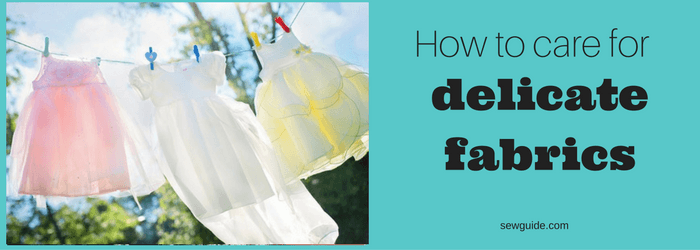Sewing some thin fabrics can be extremely difficult. But when they are very thin and sheer, it becomes doubly so. Transparent fabrics are see-through fabrics through which you can see the skin, whereas sheer fabrics are semi-transparent. All transparent materials are sheer, obviously.
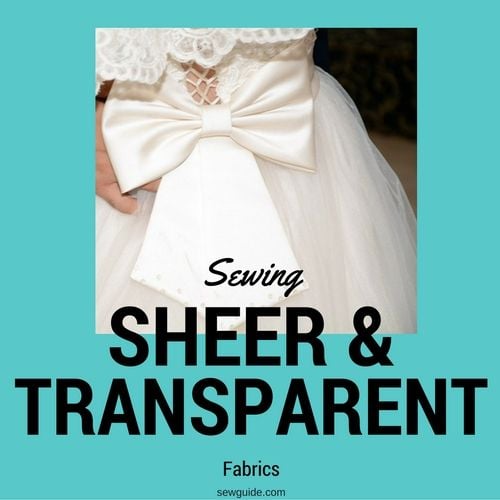
Making clothes with these fabrics are a trend that comes and goes. But their ethereal beauty makes a comeback every now and then. Diaphanous was a word I read a lot in old regency novels. The ball gowns of regency beauties grew more and more see through and bold with years.
Different types of Sheer Fabric
- Different types of Sheer Fabric
- How to design a sheer and transparent look
- How to avoid the sheer look in sheer fabrics?
- How to sew sheer, lightweight fabric?
- Best Seams for sheers
- How to embroider on sheer fabric
- Caring for the fabric
- Which needle is best to sew thin fabrics and sheers?
- Which thread is best to sew the thin, see through material?
- Which interfacing to use under sheer material?
- How to hem the edges of thin fabrics and sheers?
- How to mark on sheer fabric?
- Tips for cutting these thin, see-through materials?
- Organdie
- Lace
- Fine cotton lawn and voiles
- Mesh
- Batiste
- Tulle and netting
- Clear plastic / rubber
- Gauze
- Thin drapery materials
- Thin knits
- Eyelet fabric & other perforated materials
- Semi sheer muslin
- Silk sheers
Silk Batiste – This is a fine silk fabric with a very lustrous face.
Silk chiffon – This is a beauty, very drapey and thin. Some chiffon has a crinkled texture.
Silk georgette – This is a sheer, lightweight crepe fabric. The crinkly texture of the fabric is quite attractive.
Silk organza – This is a very crisp, somewhat stiff, and lustrous fabric.
Checkout a list of different types of sheer see through fabrics and the other 50 different names for silk fabrics
Related post
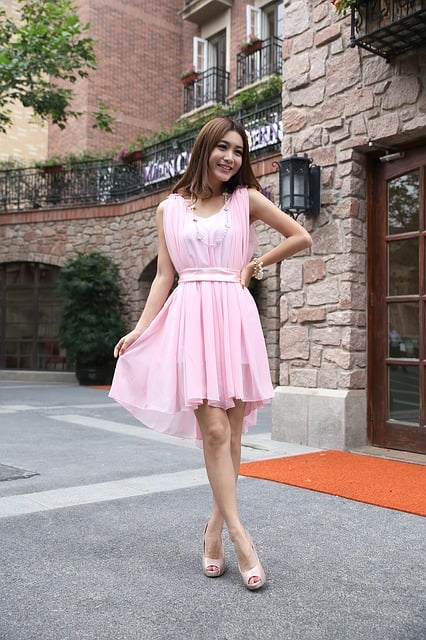
How to design a sheer and transparent look
Pairing sheer fabric with embroidery, printed fabrics, and ruffles look great. Just think about your tutu ballerina skirt- Layering sheer makes a tutu dreamlike. A boho-chic look with layers of fabric in a maxi skirt is another look to aim for.
A simple bustier can be paired with a sheer shrug. I love the look of a sheer white blouse worn over a simple camisole.
Light colors and pastel colors, white, and even neutral colors work best in sheer. A sheer insert can be added to the back of your blouse or t-shirt.
You can pair other fabric with sheer by adding it as sleeves or as an illusion neckline. Cuffs and collars, and overlays are other areas where sheer is used to perfection.
Horsehair braid hemmed petticoats are usually used under sheer dress skirts for that billowing effect. Half slips are used for modesty’s sake.

How to avoid the sheer look in sheer fabrics?
Why would you avoid the look of sheer fabrics if they are in the right place? An illusion neckline is one of the prettiest of all necklines on gowns and dresses. A see-through lace on the back of wedding gowns – nothing to say!
Do you know that if you are making a skirt with net alone you will need at least 5 layers to make it somewhat opaque to maintain your modesty. The beautiful many layered tulle gowns are usually made of more than 12 layers.
If you are daring to wear sheer alone, go for delicate pastel colors which will look flattering on anyone.
If you are shy of the transparency involved, choose embroidered sheer fabrics. It may be a pain to sew with but well worth the look.
Hand embroidery is done on sheer fabric like shadow work, or chikankari work will take it to another level. When all-over embroidery work is done on sheer or transparent fabric, they are as good as opaque.
Adding panels of transparent cloth to portions of the dress, like the hem, midriff, etc., is another way of adding this fabric to your clothes without revealing much. If you love a sheer top but are wary of wearing it, pair it with a blazer or jacket- that will tone down the look and give grace. Layering many layers of sheer fabric will give you an opaque effect that will still convey the ethereal look you aim for.
A great way to use sheer fabric without losing your modesty is to fold them, manipulate them and use them in different ways and different parts of the garment. This will also create different color effects which look stunning against certain base materials.
Satin used as lining for sheer and transparent fabrics gives it a luminous glow. A sheer fabric quilted over a pretty patterned cloth can be used to make garments with a stunning appeal.
A petticoat/pettiskirt worn under a sheer overlay is another great idea.
How to sew sheer, lightweight fabric?
For me, what makes me get that sinking feeling when I think of sewing with the most gorgeous sheer fabric I have is the fabric sinking into the needle plate. It is a horrible feeling to wonder If the material is torn. There are ways around it, and people have been sewing with these gorgeous fabrics for eons.
Best Seams for sheers
Wind the bobbin thread for sewing the sheer and transparent fabrics very slowly. A stretched bobbin thread is not advisable. The tension of the sewing machine should be slightly loose.
Machine embroidery thread or lingerie thread is preferred to all purpose thread for the delicate fabrics.
As you obviously can see through the sheer and transparent fabrics, it is advisable to use a french seam or flat fell seam. Checkout the tutorial on how to sew french seams & how to sew the seams .
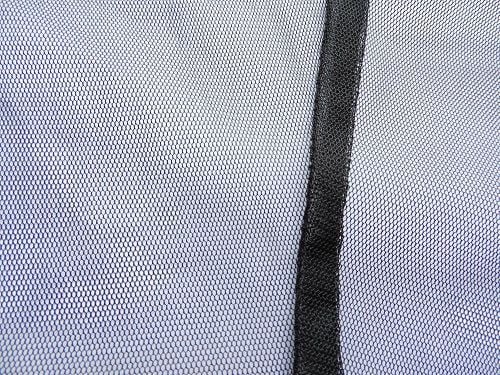
A french seam encloses the cut edges neatly within another fold, so the seam looks as neat as possible.
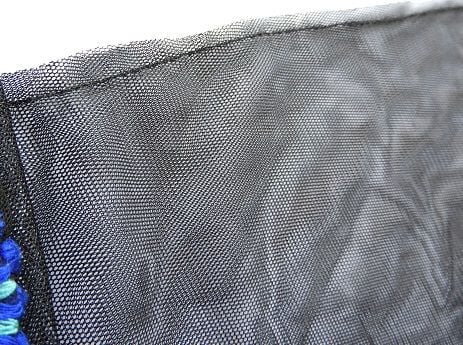
To make this, stitch the fabric edges wrong sides together at first, Trim the seam allowance and then stitch the seam right sides together.
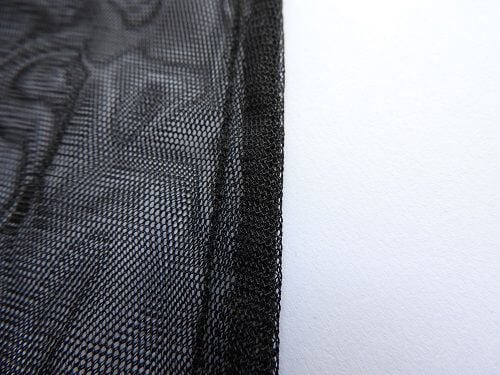
This will enclose the fabric edges beyond the seam line neatly.
If you have fabric edges, use a fray preventer, as it is a very unsightly sight to see the raveling mess these fabrics make. You can also use the overcast stitch (hand or machine) to finish the edges. Or, If you own a serger, you can make a 3-thread overlock stitch on your serger and fabric the wrong sides together for the edges. Then turn the fabric’s right sides together and stitch the french seam on your sewing machine ¼” from the fabric edge. This french seam cum serged seam will prevent any possibility of fraying and make it fully secure.
Some people do not like the stiffness given by the french and flat fell seam ; then it is best to use a straight seam and trim the seam allowance to 1/4 inch and zigzag the edges.
When sewing seams in net, make a straight seam, make another straight stitch 1/8 inch near to it; then trim away close to the last stitching line.
Facings will have to be replaced by bindings unless the sheer fabric is lined as the facings will show through. Double bindings work the best.
Pattern weights are your friend when sewing these lightweight fabrics, as they either flow in the wind ( Make sure the fan is off) or shift and slip. The pins you use had better be the sharpest. You want to avoid snagging threads and ruining the pretty fabric.
Backstitching at the end of the seams is a danger when sewing with sheer. So leave long tails and tie off.
How to embroider on sheer fabric
Sheer fabrics are delicate and light in weight. They get damaged when stretched on the embroidery hoop. The best solution for this is to wrap the hoops in thin pieces of lightweight cotton fabric.
What I do is another easy way – I cut two rings of the thin fabric and sandwich this in between the inner ring of the hoop.
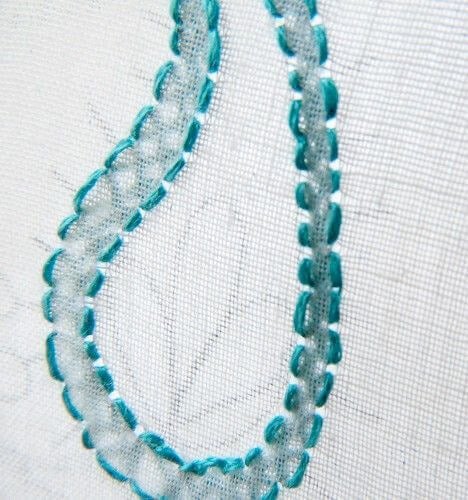
Shadow embroidery and Chikankari embroidery are the best work done on sheer fabric. They look stunning when done diligently and neatly because of the way the work appears as a deeper shadow on the face of the fabric.
If you want to do some embroidery/beading work on the net, you may need help transfering embroidery designs on to the fabric. Usually, trace the design on tissue paper, keep it under the net and work the designs on the net together with the tissue. After the work is done, you can tear off the tissue paper.
Caring for the fabric
You may want to prewash the fabric as you would do with any other when sewing. But if you want a particular effect (for eg. the stiff look of organdy) you may have to skip this step as these sheers may have that because of the finishes done on them.
Checkout the post on washing clothes by hand – hand washing is definitely the way to care for your sheer and transparent fabric. These delicate fabrics cannot handle the tumble in a washing machine. Do not wring too harshly. Just squeeze the water gently and dry flat on a rack. The water on the cloth may make the cloth sag
When ironing the sheer fabric ( especially if it is a synthetic sheer) do use the low setting of heat and a press cloth. Direct contact with heat may damage the fabric.
How to set up a sewing machine to sew sheer?
The best way to sew with sheer fabric is to Lower the stitch length, tension, and pressure foot pressure.
Which needle is best to sew thin fabrics and sheers?
Which thread is best to sew the thin, see through material?
Use cotton-covered polyester thread and a universal 75/11 or 80/12 machine needle. Sew with a straight stitch–12 to 16 stitches per inch (1.5 mm to 2 mm)
Which interfacing to use under sheer material?
When you have to interface a sheer fabric, you will have to do it with the fabric itself, as any other fabric used for interfacing will show through. So when you buy sheer to sew something, calculate this as well. Other sheers that can be used as interfacing are flesh-colored nylon tricot, organdy, organza, china silk, voile, or tulle.
In some cases, a fusible knit interfacing which is sheer, can be used. This will offer just the right amount of support but retains the beautiful drape of a fabric.
How to hem the edges of thin fabrics and sheers?
A narrow hem or a rolled edge is the most suitable finish for the hems of clothes made with these thin fabrics. I prefer a narrow hem as I sometimes have trouble with the rolled edge especially with chiffon. To do a narrow hem, I simple fold 1/4 inch inside and and stitch close to the edge ( as close as possible.) Then trim the seam allowance as close to the stitching line as possible , using a small sharp scissors. Then fold again and stitch the narrow hem. If it your first time sewing with this fabric, practice on a scrap.You can do this with a serged edge as well.
You generally do not hem net. As it doesnot fray it is usually just cut off at whichever length you want it and left it like that.
A picot edge and shell edge are other edge finishes which are suitable for sheer fabrics.Checkout the tutorials – Picot edge tutorial ; Shell edge finish tutorial, 16 hand sewn hem stitches
Many designers use the self-lining method to prevent problems in the edges when sewing with sheers. This way, facings on neck holes are eliminated. Double bodice pieces are cut, and one piece is used as the facing, which serves as the lining too. In some cases, binding with a single bias tape is also used.
When first starting sewing ( those first few stitches), you usually have problems with the sheer, thin fabrics. So a method you can use is to start stitching on a piece of paper or another scrap fabric and then continue on to the material. This way, you have some teeth ( which you miss in these delicate fabrics).
Ensure that you are not using too heavy buttons on the sheer fabric, as there is a danger of sagging.
Sleeves also can be self lined and cut double.The seam at the hem can be eliminated in this way. But some like the sheer look of the sleeves. In which case careful hand hemming is recommended.
When I am sewing dresses or skirts in delicate sheer fabrics, I always wait for one or two days ( with them hanging in the cupboard) before hemming. They always stretch and sag so I let them get all of that out before finishing the hem.
How to mark on sheer fabric?
Tips for cutting these thin, see-through materials?
If you are not using a tissue, use a sheet of woven fabric on the cutting table where you will place the fabric, especially if you are cutting slippery sheer and thin fabrics. Hold the fabric firmly with your free hand when cutting.
Some sheer fabrics like lace have a decorative edge along the length which you can use as a hem. Keep this in mind when calculating yardage for sewing as well as when laying out the fabric for cutting.

